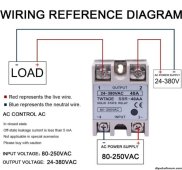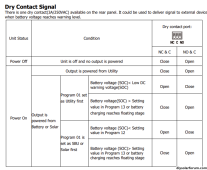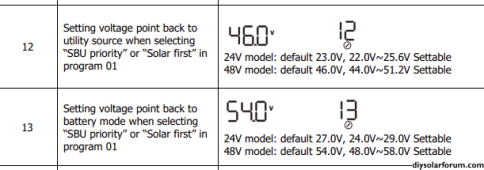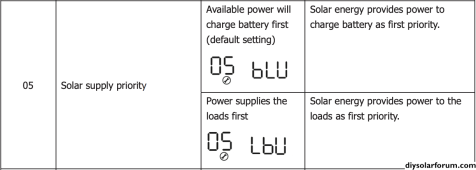Ithoughtitwouldbeeasy
New Member
Hello everyone,
I've been tirelessly searching through the sum total of human knowledge for days and finally emerged from my rabbit hole (cavern) realizing I had to make an account to ask for help to figure this out!
I'm currently running a single EG4 6000ex inverter with 2 x 51.2V 100Ah lifepower batteries. I live completely off-grid in a small cabin with very little power demand so the batteries have no problem staying full. I'm actually running a micro-hydro system and have up to 500 continuous watts. I live in Canada and heat solely with wood so I'm trying to set up a diversion/dump load hopefully to an electric baseboard heater to keep my place warmer during the winter with the excess power. So here's my thoughts:
I'd like to use the dry contact signal (DCS) on the EG4 6000 to signal a solid state relay that will divert the pv input from the batteries to the heater once the batteries are full. Sounds simple enough right! Haha...wrong! ?
I understand the DCS produces no voltage, it's really just a switch but it's rated to 3A/250VAC.
I have program 1 set to SBU (Solar/Battery/Utility).
I have program 14 set to USE (user-defined)
Bulk Charge (17) 56.0V
Float Charge (18) 54.0V
Low DC cut-off (19) 48.0V

Program 20 is at default 46.0V (Can go as high as 51V)
Program 21 is at 54.0 V (Same as Float Charge)
So my understanding is that once the SSR is connected to the NC & C terminals, the DCS will trigger the SSR when the battery voltage goes above 54.0V. So far so good...i think. Ok so now how does it turn off? It surely can't wait until the batteries have discharged below Program 20: 46V, or even 51V! That seems way too low. Or does it turn it off when it drops below 54.1V? Seems like the heater will constantly be turning off and on if the only variable is 0.1V. Ok that's me stumped #1.
#2 is how to wire the SSR.

This is my SSR and the wiring diagram. My guess is it gets power from the main panel to the input (live wire to terminal #3 and neutral wire to terminal #4) using 14/2 wire at 120VAC. Live wire then goes from terminal #1 (output) to the heater and that leaves terminal #2 (output). Do you connect a live wire to the C terminal of the DCS and the Neutral wire from the load to the NC terminal of the DCS?
If you might have any info on either of these, oh man would I ever appreciate some insight from anyone who knows what they're doing. I'm learning as I go and I'm equally ecstatic when I figure something out and pull-my-hair-out frustrated when I can't. What a rollercoaster!
Thanks in advance,
Your friendly Canadian amusement park enthusiast
I've been tirelessly searching through the sum total of human knowledge for days and finally emerged from my rabbit hole (cavern) realizing I had to make an account to ask for help to figure this out!
I'm currently running a single EG4 6000ex inverter with 2 x 51.2V 100Ah lifepower batteries. I live completely off-grid in a small cabin with very little power demand so the batteries have no problem staying full. I'm actually running a micro-hydro system and have up to 500 continuous watts. I live in Canada and heat solely with wood so I'm trying to set up a diversion/dump load hopefully to an electric baseboard heater to keep my place warmer during the winter with the excess power. So here's my thoughts:
I'd like to use the dry contact signal (DCS) on the EG4 6000 to signal a solid state relay that will divert the pv input from the batteries to the heater once the batteries are full. Sounds simple enough right! Haha...wrong! ?
I understand the DCS produces no voltage, it's really just a switch but it's rated to 3A/250VAC.
I have program 1 set to SBU (Solar/Battery/Utility).
I have program 14 set to USE (user-defined)
Bulk Charge (17) 56.0V
Float Charge (18) 54.0V
Low DC cut-off (19) 48.0V

Program 20 is at default 46.0V (Can go as high as 51V)
Program 21 is at 54.0 V (Same as Float Charge)
So my understanding is that once the SSR is connected to the NC & C terminals, the DCS will trigger the SSR when the battery voltage goes above 54.0V. So far so good...i think. Ok so now how does it turn off? It surely can't wait until the batteries have discharged below Program 20: 46V, or even 51V! That seems way too low. Or does it turn it off when it drops below 54.1V? Seems like the heater will constantly be turning off and on if the only variable is 0.1V. Ok that's me stumped #1.
#2 is how to wire the SSR.

This is my SSR and the wiring diagram. My guess is it gets power from the main panel to the input (live wire to terminal #3 and neutral wire to terminal #4) using 14/2 wire at 120VAC. Live wire then goes from terminal #1 (output) to the heater and that leaves terminal #2 (output). Do you connect a live wire to the C terminal of the DCS and the Neutral wire from the load to the NC terminal of the DCS?
If you might have any info on either of these, oh man would I ever appreciate some insight from anyone who knows what they're doing. I'm learning as I go and I'm equally ecstatic when I figure something out and pull-my-hair-out frustrated when I can't. What a rollercoaster!
Thanks in advance,
Your friendly Canadian amusement park enthusiast






